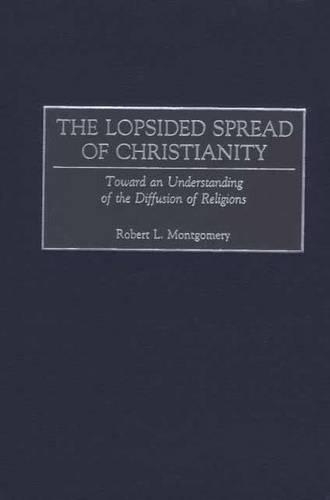
The Lopsided Spread of Christianity: Toward an Understanding of the Diffusion of Religions
(Hardback)
Publishing Details
The Lopsided Spread of Christianity: Toward an Understanding of the Diffusion of Religions
By (Author) Robert L. Montgomery
Bloomsbury Publishing PLC
Praeger Publishers Inc
30th October 2001
United States
Classifications
Tertiary Education
Non Fiction
Christianity
History of religion
270
Physical Properties
Hardback
208
Description
Comparing the spread of Christianity to the East to its more successful spread to the West, Montgomery illustrates the uneven diffusion of one of the world's most influential and successful religions. Through his sociological analysis, the author examines the causes for Christianity's success to the West and its relative failings in major societies to the east of Jerusalem, including India, Persia, and China. Applying five variables, including Christianity's missionary orientation, geography, intersocietal relations, sociocultural structures, and individual perceptions, Montgomery provides a theory of the diffusion of religion in general, and of Christianity in particular. Beginning by laying out the variables he will apply to the study, Montgomery carefully explains his approach, introducing the reader to this unique field of study. He then moves on to examine Christianity's earliest spread to areas east of Jerusalem. An examination of the rise of Islam in the East precedes a comparative analysis of the success of Christianity in its spread to the West to its relative failure to spread to the East. He concludes with a discussion of religious pluralism. Groundbreaking in its attempt to establish a better understanding of religious diffusion, this work will be indispensable to those interested in the study of sociology of religions, religious studies, missionary studies, and Christianity.
Reviews
.,."sociology is a discipline with which missiology must learn to relate and this book is a good beginning."-The Princeton Seminary Bulletin
...sociology is a discipline with which missiology must learn to relate and this book is a good beginning.-The Princeton Seminary Bulletin
Christianity originated in the eastern Mediterranean but is identified with the Western world. Facts about its spread to the East in the first millennium of its existence are not generally known. Montgomery (a retired missionary) seeks to explain the successes and failures of the Eastern missionary drives as compared to the Western efforts. In this sociological work, he applies diffusion theory to historical data. His analysis is also guided by rational choice theory, social identity theory, and network concepts. The theoretical framework is outlined early and is used very clearly throughout. Some variables (e.g., missionary drive, geographical access) are viewed as necessary but not sufficient to explain the directional spread of Christianity. Other variables (e.g., intersocietal relationships, sociocultural characteristics of the "receiving" societies, and perceptions of "rewards" gained by those who adopt the new religion) are more complex and difficult to analyze from historical data, but yield persuasive results. The writing and analysis is very clear and appears to be faithful to the data. Problematic areas are duly noted, and directions for further research are suggested. Highly recommended for historical sociologists, historians of Christianity or of new religions in general, and others at the graduate student level or higher who are interested in the topic.-Choice
The study of religious pluralism is a vital topic for the sociology of religion, and Montgomery contributes greatly to the discussion.-Sociology of Religion
..."sociology is a discipline with which missiology must learn to relate and this book is a good beginning."-The Princeton Seminary Bulletin
"The study of religious pluralism is a vital topic for the sociology of religion, and Montgomery contributes greatly to the discussion."-Sociology of Religion
"Christianity originated in the eastern Mediterranean but is identified with the Western world. Facts about its spread to the East in the first millennium of its existence are not generally known. Montgomery (a retired missionary) seeks to explain the successes and failures of the Eastern missionary drives as compared to the Western efforts. In this sociological work, he applies diffusion theory to historical data. His analysis is also guided by rational choice theory, social identity theory, and network concepts. The theoretical framework is outlined early and is used very clearly throughout. Some variables (e.g., missionary drive, geographical access) are viewed as necessary but not sufficient to explain the directional spread of Christianity. Other variables (e.g., intersocietal relationships, sociocultural characteristics of the "receiving" societies, and perceptions of "rewards" gained by those who adopt the new religion) are more complex and difficult to analyze from historical data, but yield persuasive results. The writing and analysis is very clear and appears to be faithful to the data. Problematic areas are duly noted, and directions for further research are suggested. Highly recommended for historical sociologists, historians of Christianity or of new religions in general, and others at the graduate student level or higher who are interested in the topic."-Choice
Author Bio
ROBERT L. MONTGOMERY is a retired missionary, teacher, and minister. He has published numerous journal articles, and his books include The Diffusion of Religions: A Sociological Perspective, and Introduction to the Sociology of Missions (Praeger 1999).
